Circular Economy in Electric Motorcycles: A Sustainability Report
VerifiedAdded on 2022/11/16
|16
|4458
|384
Report
AI Summary
This report examines the application of the circular economy to electric motorcycles, focusing on the components, lifecycle, and sustainability of these vehicles. The report begins with an introduction to the circular economy and its principles, emphasizing waste minimization and resource efficiency. It then delves into the various components of electric motorcycles, including structural, electrical, and miscellaneous parts, assessing their suitability for circular economy practices. The report highlights the importance of design in facilitating reuse, repair, and recycling of components. Furthermore, it explores the transition from a linear to a circular economy model, outlining the principles of designing out waste, building resilience, and utilizing renewable energy sources. The report also describes a future sustainable industrial system, considering the stages in the lifecycle of an electric motorcycle. It emphasizes the importance of life cycle assessment (LCA) in evaluating the environmental impact of raw material extraction, production, consumption, and end-of-life management. The report concludes by providing recommendations for short-term and long-term steps that the company should take to embrace circular economy principles, including material substitution, promoting recycling, and reducing waste generation.

Running head: ECONOMICS
Economics
Name of the university
Name of the student
Economics
Name of the university
Name of the student
Paraphrase This Document
Need a fresh take? Get an instant paraphrase of this document with our AI Paraphraser
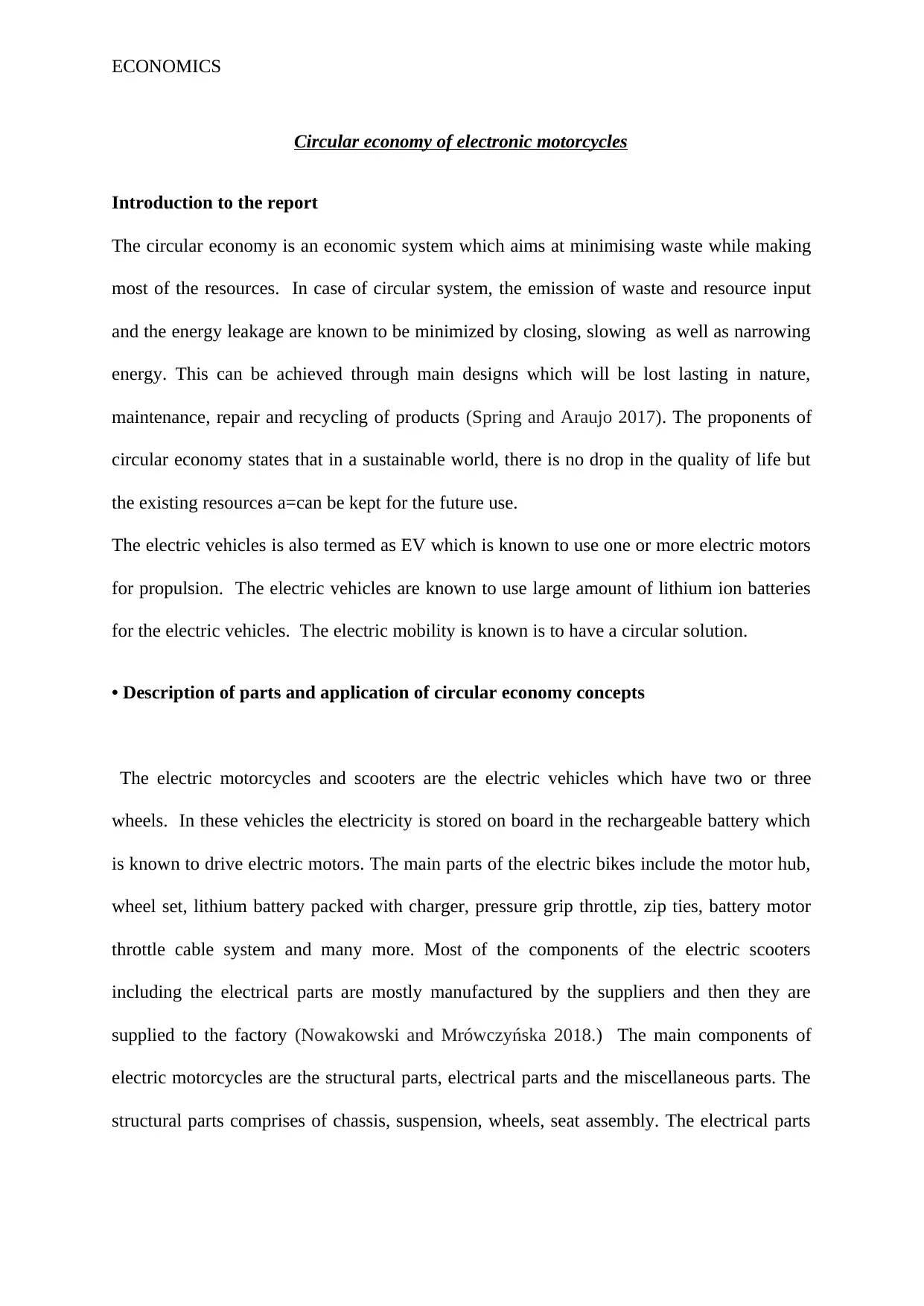
ECONOMICS
Circular economy of electronic motorcycles
Introduction to the report
The circular economy is an economic system which aims at minimising waste while making
most of the resources. In case of circular system, the emission of waste and resource input
and the energy leakage are known to be minimized by closing, slowing as well as narrowing
energy. This can be achieved through main designs which will be lost lasting in nature,
maintenance, repair and recycling of products (Spring and Araujo 2017). The proponents of
circular economy states that in a sustainable world, there is no drop in the quality of life but
the existing resources a=can be kept for the future use.
The electric vehicles is also termed as EV which is known to use one or more electric motors
for propulsion. The electric vehicles are known to use large amount of lithium ion batteries
for the electric vehicles. The electric mobility is known is to have a circular solution.
• Description of parts and application of circular economy concepts
The electric motorcycles and scooters are the electric vehicles which have two or three
wheels. In these vehicles the electricity is stored on board in the rechargeable battery which
is known to drive electric motors. The main parts of the electric bikes include the motor hub,
wheel set, lithium battery packed with charger, pressure grip throttle, zip ties, battery motor
throttle cable system and many more. Most of the components of the electric scooters
including the electrical parts are mostly manufactured by the suppliers and then they are
supplied to the factory (Nowakowski and Mrówczyńska 2018.) The main components of
electric motorcycles are the structural parts, electrical parts and the miscellaneous parts. The
structural parts comprises of chassis, suspension, wheels, seat assembly. The electrical parts
Circular economy of electronic motorcycles
Introduction to the report
The circular economy is an economic system which aims at minimising waste while making
most of the resources. In case of circular system, the emission of waste and resource input
and the energy leakage are known to be minimized by closing, slowing as well as narrowing
energy. This can be achieved through main designs which will be lost lasting in nature,
maintenance, repair and recycling of products (Spring and Araujo 2017). The proponents of
circular economy states that in a sustainable world, there is no drop in the quality of life but
the existing resources a=can be kept for the future use.
The electric vehicles is also termed as EV which is known to use one or more electric motors
for propulsion. The electric vehicles are known to use large amount of lithium ion batteries
for the electric vehicles. The electric mobility is known is to have a circular solution.
• Description of parts and application of circular economy concepts
The electric motorcycles and scooters are the electric vehicles which have two or three
wheels. In these vehicles the electricity is stored on board in the rechargeable battery which
is known to drive electric motors. The main parts of the electric bikes include the motor hub,
wheel set, lithium battery packed with charger, pressure grip throttle, zip ties, battery motor
throttle cable system and many more. Most of the components of the electric scooters
including the electrical parts are mostly manufactured by the suppliers and then they are
supplied to the factory (Nowakowski and Mrówczyńska 2018.) The main components of
electric motorcycles are the structural parts, electrical parts and the miscellaneous parts. The
structural parts comprises of chassis, suspension, wheels, seat assembly. The electrical parts
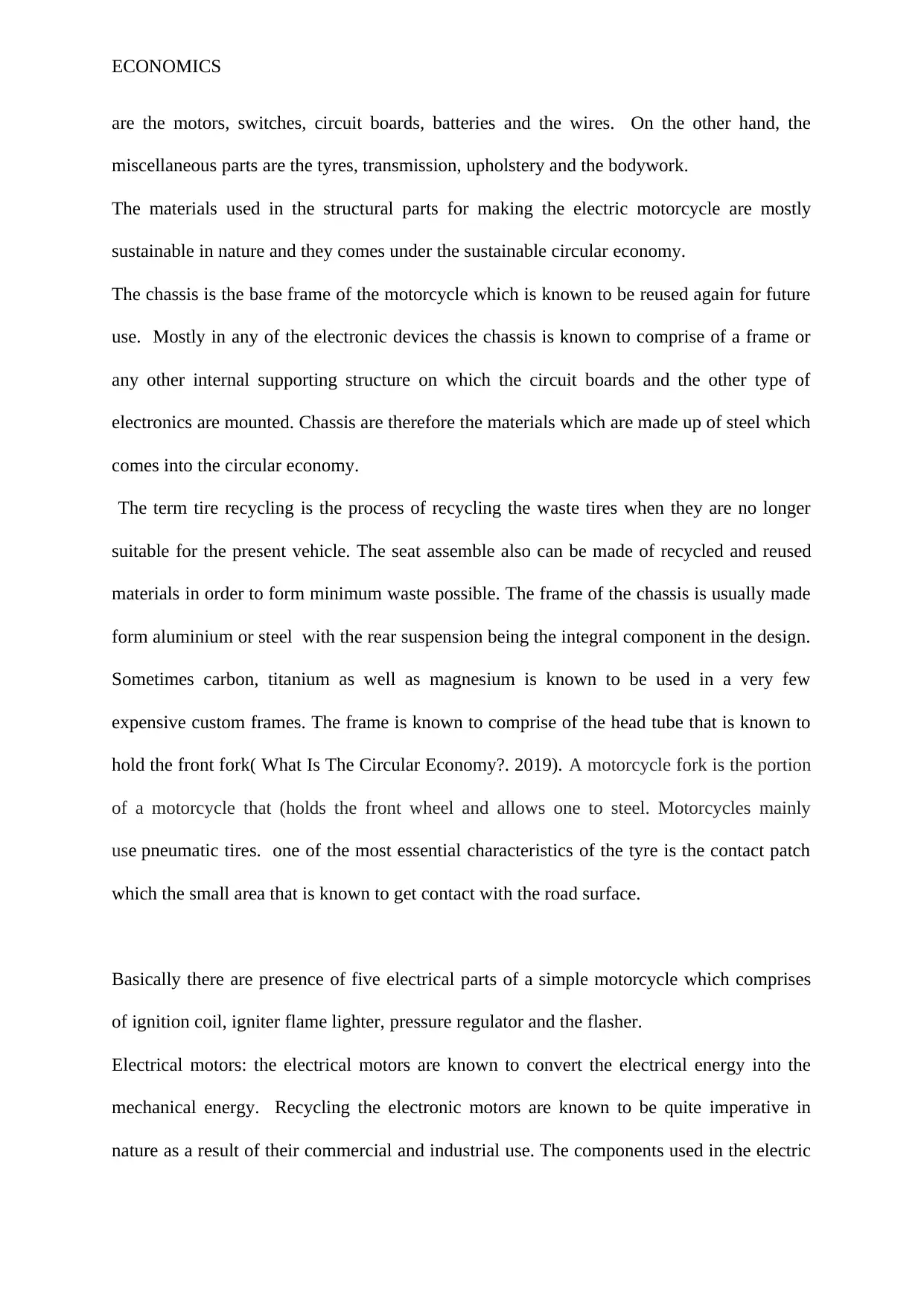
ECONOMICS
are the motors, switches, circuit boards, batteries and the wires. On the other hand, the
miscellaneous parts are the tyres, transmission, upholstery and the bodywork.
The materials used in the structural parts for making the electric motorcycle are mostly
sustainable in nature and they comes under the sustainable circular economy.
The chassis is the base frame of the motorcycle which is known to be reused again for future
use. Mostly in any of the electronic devices the chassis is known to comprise of a frame or
any other internal supporting structure on which the circuit boards and the other type of
electronics are mounted. Chassis are therefore the materials which are made up of steel which
comes into the circular economy.
The term tire recycling is the process of recycling the waste tires when they are no longer
suitable for the present vehicle. The seat assemble also can be made of recycled and reused
materials in order to form minimum waste possible. The frame of the chassis is usually made
form aluminium or steel with the rear suspension being the integral component in the design.
Sometimes carbon, titanium as well as magnesium is known to be used in a very few
expensive custom frames. The frame is known to comprise of the head tube that is known to
hold the front fork( What Is The Circular Economy?. 2019). A motorcycle fork is the portion
of a motorcycle that (holds the front wheel and allows one to steel. Motorcycles mainly
use pneumatic tires. one of the most essential characteristics of the tyre is the contact patch
which the small area that is known to get contact with the road surface.
Basically there are presence of five electrical parts of a simple motorcycle which comprises
of ignition coil, igniter flame lighter, pressure regulator and the flasher.
Electrical motors: the electrical motors are known to convert the electrical energy into the
mechanical energy. Recycling the electronic motors are known to be quite imperative in
nature as a result of their commercial and industrial use. The components used in the electric
are the motors, switches, circuit boards, batteries and the wires. On the other hand, the
miscellaneous parts are the tyres, transmission, upholstery and the bodywork.
The materials used in the structural parts for making the electric motorcycle are mostly
sustainable in nature and they comes under the sustainable circular economy.
The chassis is the base frame of the motorcycle which is known to be reused again for future
use. Mostly in any of the electronic devices the chassis is known to comprise of a frame or
any other internal supporting structure on which the circuit boards and the other type of
electronics are mounted. Chassis are therefore the materials which are made up of steel which
comes into the circular economy.
The term tire recycling is the process of recycling the waste tires when they are no longer
suitable for the present vehicle. The seat assemble also can be made of recycled and reused
materials in order to form minimum waste possible. The frame of the chassis is usually made
form aluminium or steel with the rear suspension being the integral component in the design.
Sometimes carbon, titanium as well as magnesium is known to be used in a very few
expensive custom frames. The frame is known to comprise of the head tube that is known to
hold the front fork( What Is The Circular Economy?. 2019). A motorcycle fork is the portion
of a motorcycle that (holds the front wheel and allows one to steel. Motorcycles mainly
use pneumatic tires. one of the most essential characteristics of the tyre is the contact patch
which the small area that is known to get contact with the road surface.
Basically there are presence of five electrical parts of a simple motorcycle which comprises
of ignition coil, igniter flame lighter, pressure regulator and the flasher.
Electrical motors: the electrical motors are known to convert the electrical energy into the
mechanical energy. Recycling the electronic motors are known to be quite imperative in
nature as a result of their commercial and industrial use. The components used in the electric
⊘ This is a preview!⊘
Do you want full access?
Subscribe today to unlock all pages.

Trusted by 1+ million students worldwide

ECONOMICS
motors are the shaft, copper windings, stator, case, commutator, armature and bearings.
Recycling the electric motors are taken place on a huge scale and for this reason, the electric
motors do not have enough copper windings.
Switches: switches can be transformed and reused and used in case of circular economy, the
wires can then be used again if they can be recycled again. The batteries used in the
electronic motorcycles are mostly rechargeable in nature which are mostly made up of
lithium. They are even termed as the lithium ion motorcycles (Cucchiella ET AL. 2016).
When better batteries are used for making the electronic motorcycles it is known to provide
cleaner alternative to the pollution sweeping has powered bikes. The advanced battery
technologies used are known to enable much cleaner alternative to pollution. Advanced
rechargeable batteries are the enablers of energy which is used in multiple applications like
the cordless power tools, e communication devices, e mobility transportation.
It is usually known to take place between 2 to 6 hours in order to charge a battery completely.
The actual time is known to depend on the size as well as the type of the battery.
From linear economy to circular economy
The circular economy is the industrial system which regenerative by intentions and designs.
It is known to replace with the end of life concept with the restoration, shifting towards the
usage of renewable energy, elimination of the use of toxic materials and also aims for
elimination of waste through superior design of the materials. The circular economy is known
to design out the waste. The products are known to get designed and also get optimised for
reusing. On the other hand, the linear model relies on the large quantities of easily accessible
resources as well as energy. In case of circular system, the emission of waste and resource
input and the energy leakage are known to be minimized by closing, slowing as well as
narrowing energy. This can be achieved through main designs which will be lost lasting in
nature, maintenance, repair and recycling of products
motors are the shaft, copper windings, stator, case, commutator, armature and bearings.
Recycling the electric motors are taken place on a huge scale and for this reason, the electric
motors do not have enough copper windings.
Switches: switches can be transformed and reused and used in case of circular economy, the
wires can then be used again if they can be recycled again. The batteries used in the
electronic motorcycles are mostly rechargeable in nature which are mostly made up of
lithium. They are even termed as the lithium ion motorcycles (Cucchiella ET AL. 2016).
When better batteries are used for making the electronic motorcycles it is known to provide
cleaner alternative to the pollution sweeping has powered bikes. The advanced battery
technologies used are known to enable much cleaner alternative to pollution. Advanced
rechargeable batteries are the enablers of energy which is used in multiple applications like
the cordless power tools, e communication devices, e mobility transportation.
It is usually known to take place between 2 to 6 hours in order to charge a battery completely.
The actual time is known to depend on the size as well as the type of the battery.
From linear economy to circular economy
The circular economy is the industrial system which regenerative by intentions and designs.
It is known to replace with the end of life concept with the restoration, shifting towards the
usage of renewable energy, elimination of the use of toxic materials and also aims for
elimination of waste through superior design of the materials. The circular economy is known
to design out the waste. The products are known to get designed and also get optimised for
reusing. On the other hand, the linear model relies on the large quantities of easily accessible
resources as well as energy. In case of circular system, the emission of waste and resource
input and the energy leakage are known to be minimized by closing, slowing as well as
narrowing energy. This can be achieved through main designs which will be lost lasting in
nature, maintenance, repair and recycling of products
Paraphrase This Document
Need a fresh take? Get an instant paraphrase of this document with our AI Paraphraser
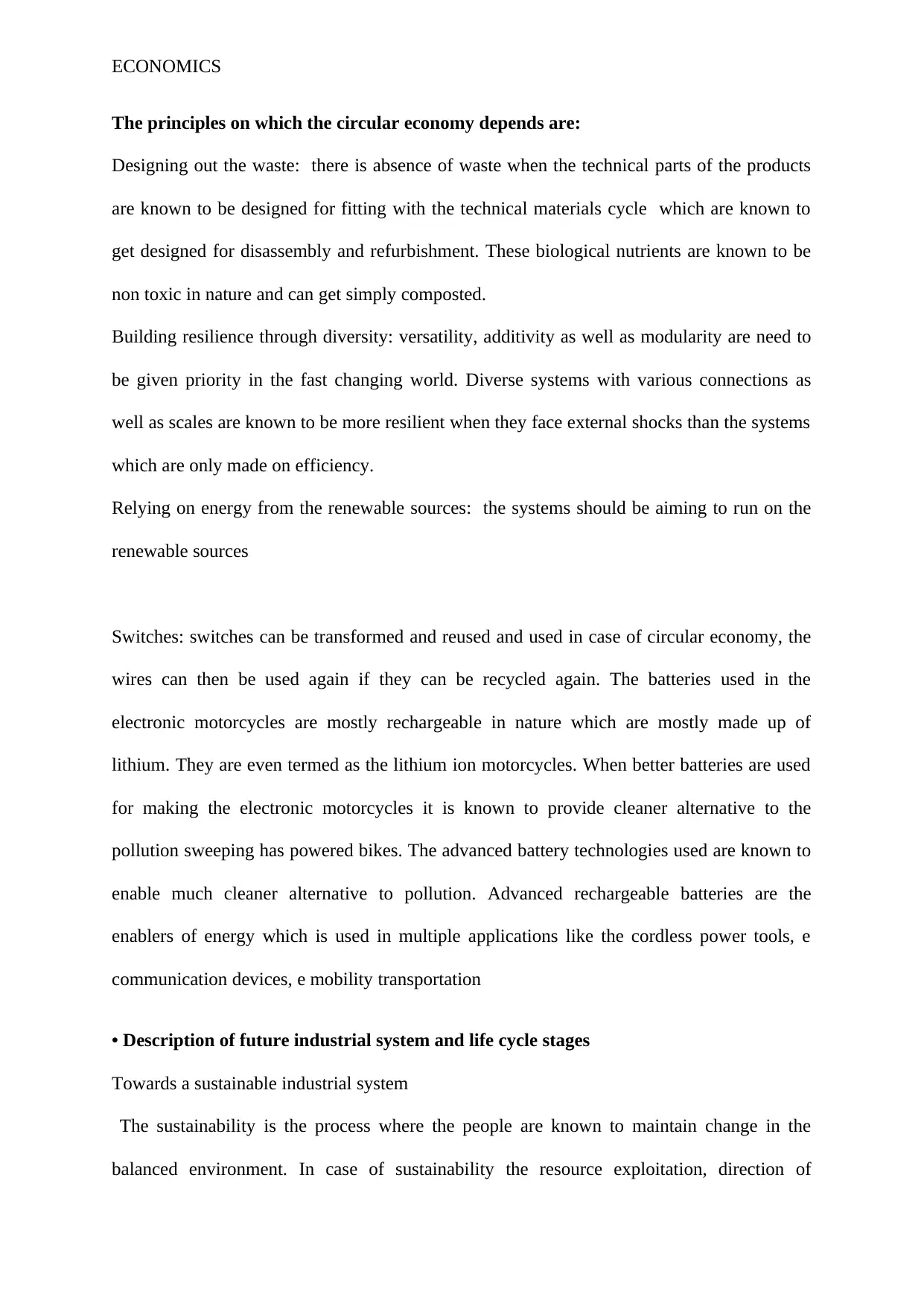
ECONOMICS
The principles on which the circular economy depends are:
Designing out the waste: there is absence of waste when the technical parts of the products
are known to be designed for fitting with the technical materials cycle which are known to
get designed for disassembly and refurbishment. These biological nutrients are known to be
non toxic in nature and can get simply composted.
Building resilience through diversity: versatility, additivity as well as modularity are need to
be given priority in the fast changing world. Diverse systems with various connections as
well as scales are known to be more resilient when they face external shocks than the systems
which are only made on efficiency.
Relying on energy from the renewable sources: the systems should be aiming to run on the
renewable sources
Switches: switches can be transformed and reused and used in case of circular economy, the
wires can then be used again if they can be recycled again. The batteries used in the
electronic motorcycles are mostly rechargeable in nature which are mostly made up of
lithium. They are even termed as the lithium ion motorcycles. When better batteries are used
for making the electronic motorcycles it is known to provide cleaner alternative to the
pollution sweeping has powered bikes. The advanced battery technologies used are known to
enable much cleaner alternative to pollution. Advanced rechargeable batteries are the
enablers of energy which is used in multiple applications like the cordless power tools, e
communication devices, e mobility transportation
• Description of future industrial system and life cycle stages
Towards a sustainable industrial system
The sustainability is the process where the people are known to maintain change in the
balanced environment. In case of sustainability the resource exploitation, direction of
The principles on which the circular economy depends are:
Designing out the waste: there is absence of waste when the technical parts of the products
are known to be designed for fitting with the technical materials cycle which are known to
get designed for disassembly and refurbishment. These biological nutrients are known to be
non toxic in nature and can get simply composted.
Building resilience through diversity: versatility, additivity as well as modularity are need to
be given priority in the fast changing world. Diverse systems with various connections as
well as scales are known to be more resilient when they face external shocks than the systems
which are only made on efficiency.
Relying on energy from the renewable sources: the systems should be aiming to run on the
renewable sources
Switches: switches can be transformed and reused and used in case of circular economy, the
wires can then be used again if they can be recycled again. The batteries used in the
electronic motorcycles are mostly rechargeable in nature which are mostly made up of
lithium. They are even termed as the lithium ion motorcycles. When better batteries are used
for making the electronic motorcycles it is known to provide cleaner alternative to the
pollution sweeping has powered bikes. The advanced battery technologies used are known to
enable much cleaner alternative to pollution. Advanced rechargeable batteries are the
enablers of energy which is used in multiple applications like the cordless power tools, e
communication devices, e mobility transportation
• Description of future industrial system and life cycle stages
Towards a sustainable industrial system
The sustainability is the process where the people are known to maintain change in the
balanced environment. In case of sustainability the resource exploitation, direction of
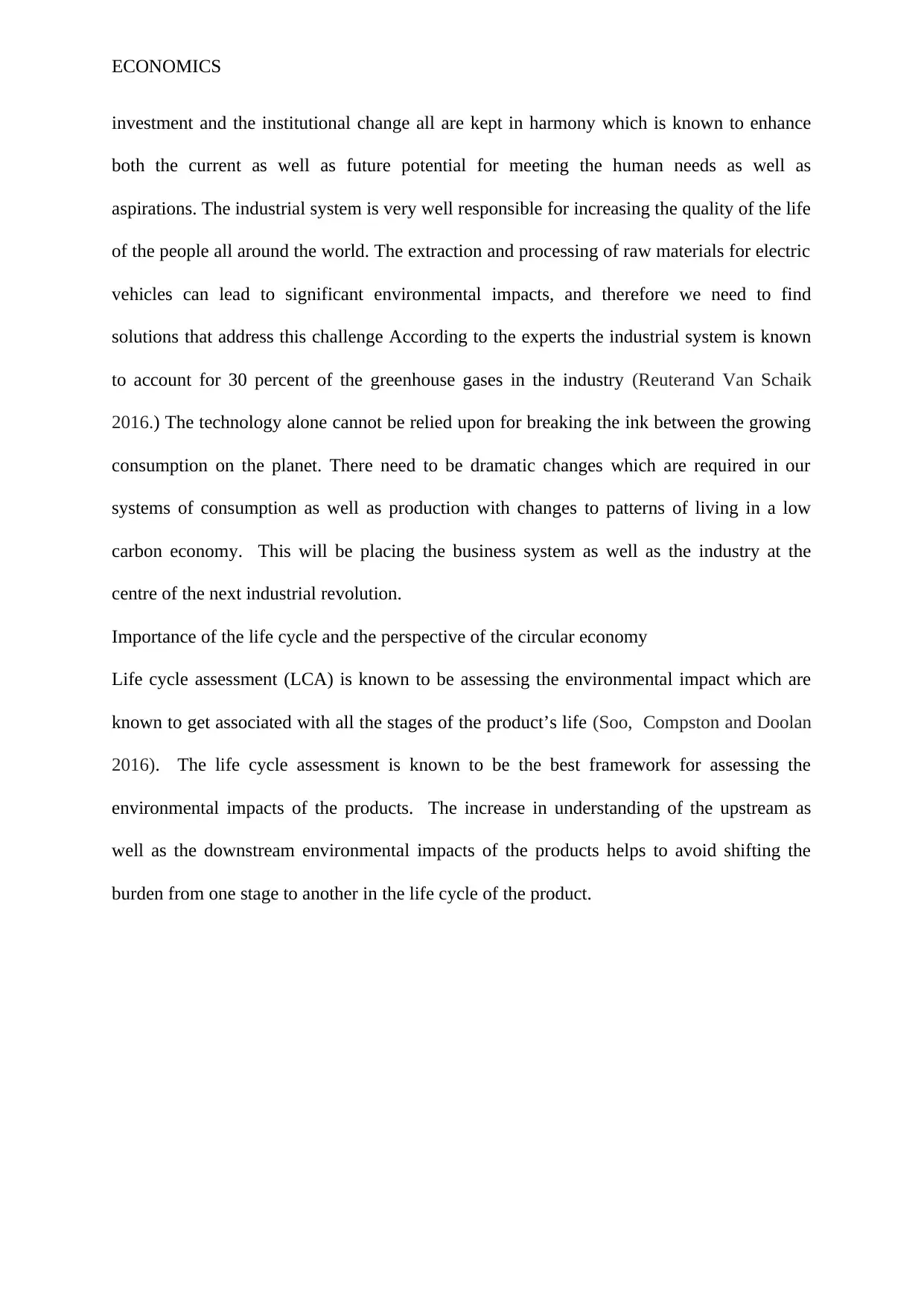
ECONOMICS
investment and the institutional change all are kept in harmony which is known to enhance
both the current as well as future potential for meeting the human needs as well as
aspirations. The industrial system is very well responsible for increasing the quality of the life
of the people all around the world. The extraction and processing of raw materials for electric
vehicles can lead to significant environmental impacts, and therefore we need to find
solutions that address this challenge According to the experts the industrial system is known
to account for 30 percent of the greenhouse gases in the industry (Reuterand Van Schaik
2016.) The technology alone cannot be relied upon for breaking the ink between the growing
consumption on the planet. There need to be dramatic changes which are required in our
systems of consumption as well as production with changes to patterns of living in a low
carbon economy. This will be placing the business system as well as the industry at the
centre of the next industrial revolution.
Importance of the life cycle and the perspective of the circular economy
Life cycle assessment (LCA) is known to be assessing the environmental impact which are
known to get associated with all the stages of the product’s life (Soo, Compston and Doolan
2016). The life cycle assessment is known to be the best framework for assessing the
environmental impacts of the products. The increase in understanding of the upstream as
well as the downstream environmental impacts of the products helps to avoid shifting the
burden from one stage to another in the life cycle of the product.
investment and the institutional change all are kept in harmony which is known to enhance
both the current as well as future potential for meeting the human needs as well as
aspirations. The industrial system is very well responsible for increasing the quality of the life
of the people all around the world. The extraction and processing of raw materials for electric
vehicles can lead to significant environmental impacts, and therefore we need to find
solutions that address this challenge According to the experts the industrial system is known
to account for 30 percent of the greenhouse gases in the industry (Reuterand Van Schaik
2016.) The technology alone cannot be relied upon for breaking the ink between the growing
consumption on the planet. There need to be dramatic changes which are required in our
systems of consumption as well as production with changes to patterns of living in a low
carbon economy. This will be placing the business system as well as the industry at the
centre of the next industrial revolution.
Importance of the life cycle and the perspective of the circular economy
Life cycle assessment (LCA) is known to be assessing the environmental impact which are
known to get associated with all the stages of the product’s life (Soo, Compston and Doolan
2016). The life cycle assessment is known to be the best framework for assessing the
environmental impacts of the products. The increase in understanding of the upstream as
well as the downstream environmental impacts of the products helps to avoid shifting the
burden from one stage to another in the life cycle of the product.
⊘ This is a preview!⊘
Do you want full access?
Subscribe today to unlock all pages.

Trusted by 1+ million students worldwide
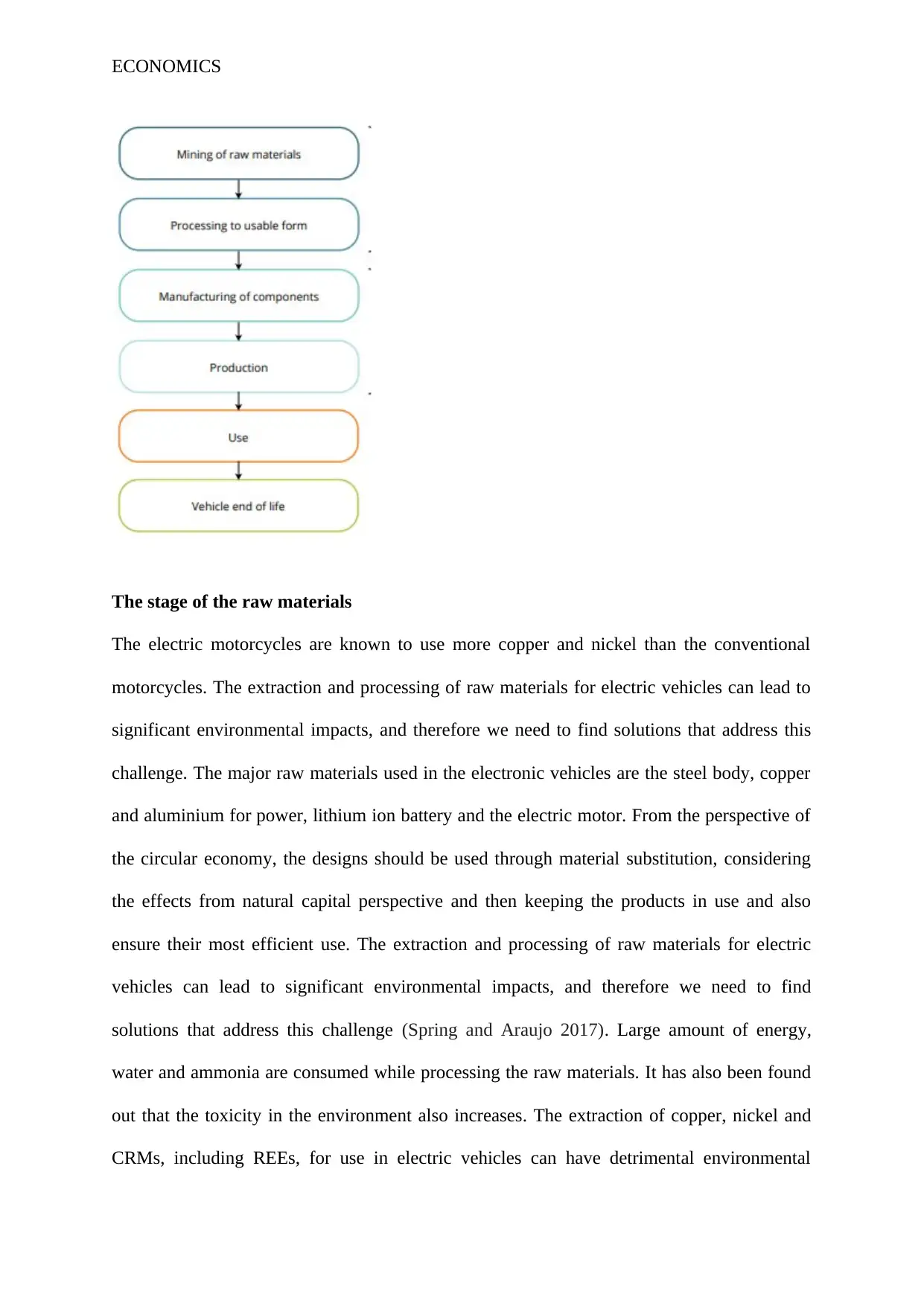
ECONOMICS
The stage of the raw materials
The electric motorcycles are known to use more copper and nickel than the conventional
motorcycles. The extraction and processing of raw materials for electric vehicles can lead to
significant environmental impacts, and therefore we need to find solutions that address this
challenge. The major raw materials used in the electronic vehicles are the steel body, copper
and aluminium for power, lithium ion battery and the electric motor. From the perspective of
the circular economy, the designs should be used through material substitution, considering
the effects from natural capital perspective and then keeping the products in use and also
ensure their most efficient use. The extraction and processing of raw materials for electric
vehicles can lead to significant environmental impacts, and therefore we need to find
solutions that address this challenge (Spring and Araujo 2017). Large amount of energy,
water and ammonia are consumed while processing the raw materials. It has also been found
out that the toxicity in the environment also increases. The extraction of copper, nickel and
CRMs, including REEs, for use in electric vehicles can have detrimental environmental
The stage of the raw materials
The electric motorcycles are known to use more copper and nickel than the conventional
motorcycles. The extraction and processing of raw materials for electric vehicles can lead to
significant environmental impacts, and therefore we need to find solutions that address this
challenge. The major raw materials used in the electronic vehicles are the steel body, copper
and aluminium for power, lithium ion battery and the electric motor. From the perspective of
the circular economy, the designs should be used through material substitution, considering
the effects from natural capital perspective and then keeping the products in use and also
ensure their most efficient use. The extraction and processing of raw materials for electric
vehicles can lead to significant environmental impacts, and therefore we need to find
solutions that address this challenge (Spring and Araujo 2017). Large amount of energy,
water and ammonia are consumed while processing the raw materials. It has also been found
out that the toxicity in the environment also increases. The extraction of copper, nickel and
CRMs, including REEs, for use in electric vehicles can have detrimental environmental
Paraphrase This Document
Need a fresh take? Get an instant paraphrase of this document with our AI Paraphraser

ECONOMICS
impacts. Therefore, small vehicles should be used, reducing the usage of aluminium and
copper in the electrical vehicles and also encouraging recycling as well as reusing of the
vehicle components.
Stage of production
From the point of life cycle perspective, the air pollutants from the battery operated electronic
vehicle are known to be much higher than the internal combustion engine vehicles. This
happens mostly due to the energy intensive process of the battery manufacture. This higher
energy usage is known to have affected health and ecosystems severely. The impacts
although varies according to the battery size used and the energy mixed used in the process of
production. Therefore, from the perspective of the circular economy, the negative
environmental impacts can get reduced by recycling that will be increasing the usage of the
recycled products instead of the virgin materials. Consumption patterns can be changed by
encouraging the consumers for choosing the smaller possible vehicle which is known to get
facilitate by shared mobility services. The waste generation should also be reduced by taking
the advantage of economies of scale and also use new techniques in battery as well as in
vehicle production. The battery type should be chosen in that manner so that it has the lowest
impact per unit of energy provided. It have been found out that there is a huge proportion of
green house gas emissions and the air pollutants are released during the production of battery
operated electric vehicle. A large proportion of greenhouse gas emissions are related for
generating electricity and other forms of energy which are required for the energy intensive
process.
impacts. Therefore, small vehicles should be used, reducing the usage of aluminium and
copper in the electrical vehicles and also encouraging recycling as well as reusing of the
vehicle components.
Stage of production
From the point of life cycle perspective, the air pollutants from the battery operated electronic
vehicle are known to be much higher than the internal combustion engine vehicles. This
happens mostly due to the energy intensive process of the battery manufacture. This higher
energy usage is known to have affected health and ecosystems severely. The impacts
although varies according to the battery size used and the energy mixed used in the process of
production. Therefore, from the perspective of the circular economy, the negative
environmental impacts can get reduced by recycling that will be increasing the usage of the
recycled products instead of the virgin materials. Consumption patterns can be changed by
encouraging the consumers for choosing the smaller possible vehicle which is known to get
facilitate by shared mobility services. The waste generation should also be reduced by taking
the advantage of economies of scale and also use new techniques in battery as well as in
vehicle production. The battery type should be chosen in that manner so that it has the lowest
impact per unit of energy provided. It have been found out that there is a huge proportion of
green house gas emissions and the air pollutants are released during the production of battery
operated electric vehicle. A large proportion of greenhouse gas emissions are related for
generating electricity and other forms of energy which are required for the energy intensive
process.
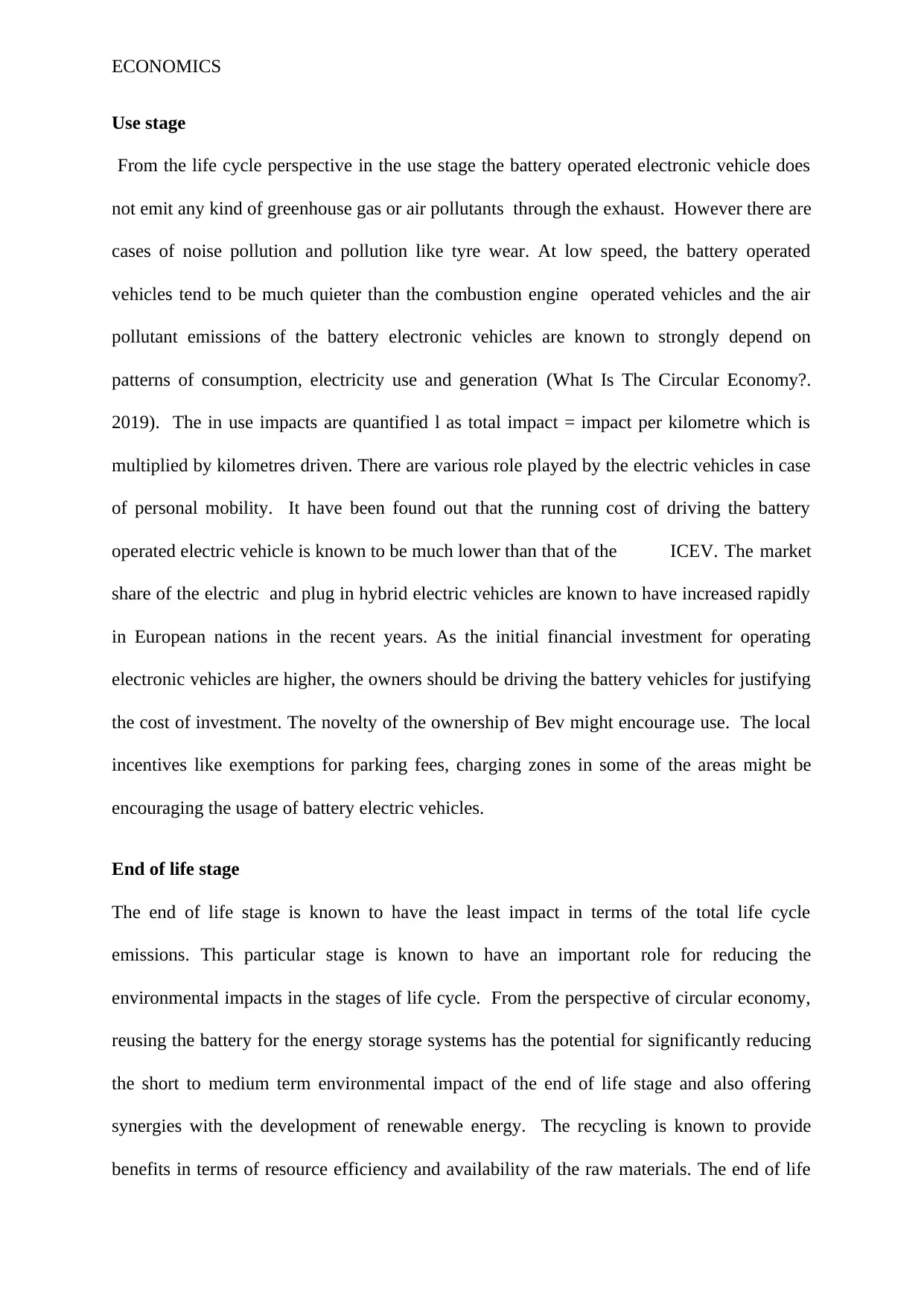
ECONOMICS
Use stage
From the life cycle perspective in the use stage the battery operated electronic vehicle does
not emit any kind of greenhouse gas or air pollutants through the exhaust. However there are
cases of noise pollution and pollution like tyre wear. At low speed, the battery operated
vehicles tend to be much quieter than the combustion engine operated vehicles and the air
pollutant emissions of the battery electronic vehicles are known to strongly depend on
patterns of consumption, electricity use and generation (What Is The Circular Economy?.
2019). The in use impacts are quantified l as total impact = impact per kilometre which is
multiplied by kilometres driven. There are various role played by the electric vehicles in case
of personal mobility. It have been found out that the running cost of driving the battery
operated electric vehicle is known to be much lower than that of the ICEV. The market
share of the electric and plug in hybrid electric vehicles are known to have increased rapidly
in European nations in the recent years. As the initial financial investment for operating
electronic vehicles are higher, the owners should be driving the battery vehicles for justifying
the cost of investment. The novelty of the ownership of Bev might encourage use. The local
incentives like exemptions for parking fees, charging zones in some of the areas might be
encouraging the usage of battery electric vehicles.
End of life stage
The end of life stage is known to have the least impact in terms of the total life cycle
emissions. This particular stage is known to have an important role for reducing the
environmental impacts in the stages of life cycle. From the perspective of circular economy,
reusing the battery for the energy storage systems has the potential for significantly reducing
the short to medium term environmental impact of the end of life stage and also offering
synergies with the development of renewable energy. The recycling is known to provide
benefits in terms of resource efficiency and availability of the raw materials. The end of life
Use stage
From the life cycle perspective in the use stage the battery operated electronic vehicle does
not emit any kind of greenhouse gas or air pollutants through the exhaust. However there are
cases of noise pollution and pollution like tyre wear. At low speed, the battery operated
vehicles tend to be much quieter than the combustion engine operated vehicles and the air
pollutant emissions of the battery electronic vehicles are known to strongly depend on
patterns of consumption, electricity use and generation (What Is The Circular Economy?.
2019). The in use impacts are quantified l as total impact = impact per kilometre which is
multiplied by kilometres driven. There are various role played by the electric vehicles in case
of personal mobility. It have been found out that the running cost of driving the battery
operated electric vehicle is known to be much lower than that of the ICEV. The market
share of the electric and plug in hybrid electric vehicles are known to have increased rapidly
in European nations in the recent years. As the initial financial investment for operating
electronic vehicles are higher, the owners should be driving the battery vehicles for justifying
the cost of investment. The novelty of the ownership of Bev might encourage use. The local
incentives like exemptions for parking fees, charging zones in some of the areas might be
encouraging the usage of battery electric vehicles.
End of life stage
The end of life stage is known to have the least impact in terms of the total life cycle
emissions. This particular stage is known to have an important role for reducing the
environmental impacts in the stages of life cycle. From the perspective of circular economy,
reusing the battery for the energy storage systems has the potential for significantly reducing
the short to medium term environmental impact of the end of life stage and also offering
synergies with the development of renewable energy. The recycling is known to provide
benefits in terms of resource efficiency and availability of the raw materials. The end of life
⊘ This is a preview!⊘
Do you want full access?
Subscribe today to unlock all pages.

Trusted by 1+ million students worldwide
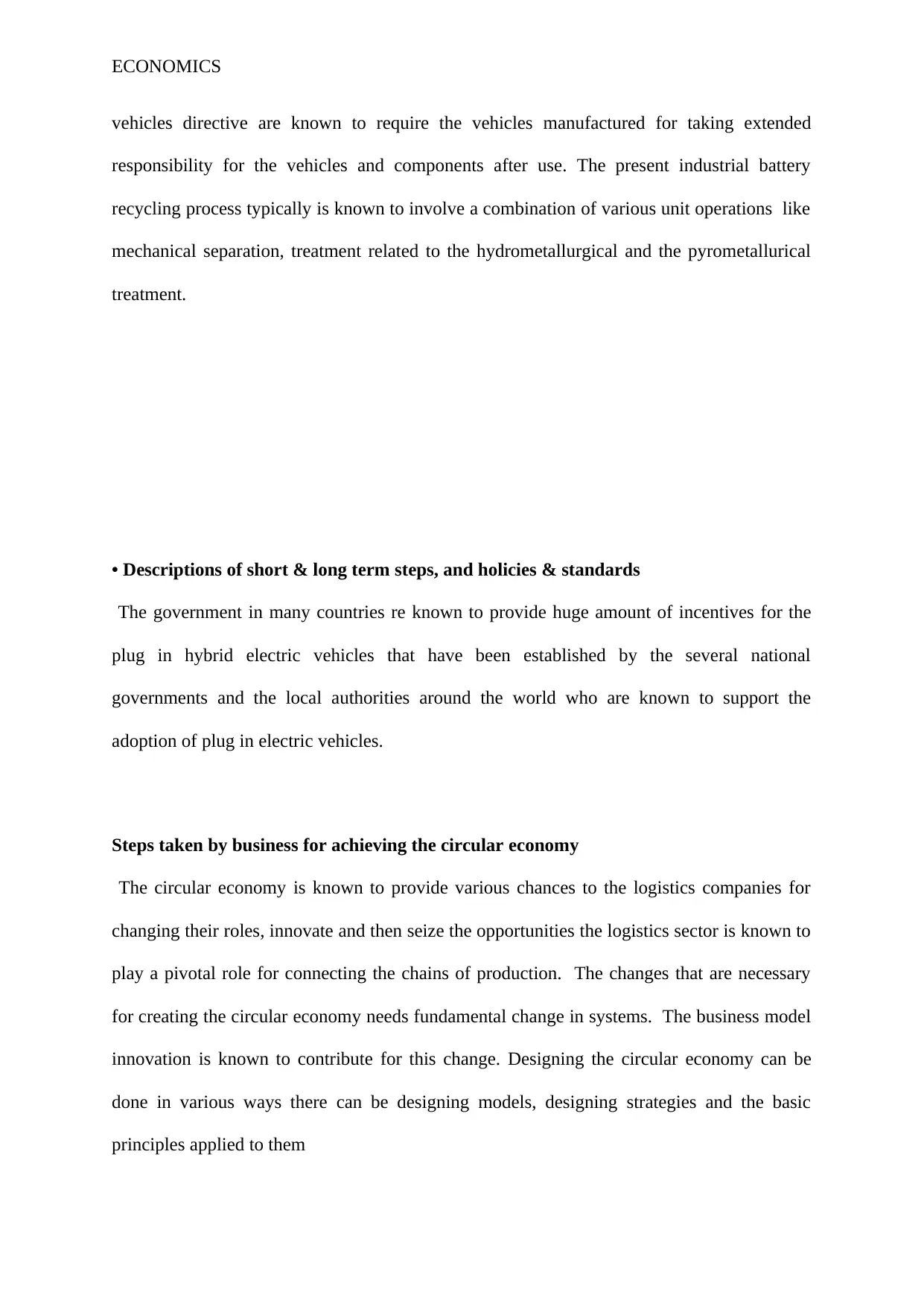
ECONOMICS
vehicles directive are known to require the vehicles manufactured for taking extended
responsibility for the vehicles and components after use. The present industrial battery
recycling process typically is known to involve a combination of various unit operations like
mechanical separation, treatment related to the hydrometallurgical and the pyrometallurical
treatment.
• Descriptions of short & long term steps, and holicies & standards
The government in many countries re known to provide huge amount of incentives for the
plug in hybrid electric vehicles that have been established by the several national
governments and the local authorities around the world who are known to support the
adoption of plug in electric vehicles.
Steps taken by business for achieving the circular economy
The circular economy is known to provide various chances to the logistics companies for
changing their roles, innovate and then seize the opportunities the logistics sector is known to
play a pivotal role for connecting the chains of production. The changes that are necessary
for creating the circular economy needs fundamental change in systems. The business model
innovation is known to contribute for this change. Designing the circular economy can be
done in various ways there can be designing models, designing strategies and the basic
principles applied to them
vehicles directive are known to require the vehicles manufactured for taking extended
responsibility for the vehicles and components after use. The present industrial battery
recycling process typically is known to involve a combination of various unit operations like
mechanical separation, treatment related to the hydrometallurgical and the pyrometallurical
treatment.
• Descriptions of short & long term steps, and holicies & standards
The government in many countries re known to provide huge amount of incentives for the
plug in hybrid electric vehicles that have been established by the several national
governments and the local authorities around the world who are known to support the
adoption of plug in electric vehicles.
Steps taken by business for achieving the circular economy
The circular economy is known to provide various chances to the logistics companies for
changing their roles, innovate and then seize the opportunities the logistics sector is known to
play a pivotal role for connecting the chains of production. The changes that are necessary
for creating the circular economy needs fundamental change in systems. The business model
innovation is known to contribute for this change. Designing the circular economy can be
done in various ways there can be designing models, designing strategies and the basic
principles applied to them
Paraphrase This Document
Need a fresh take? Get an instant paraphrase of this document with our AI Paraphraser
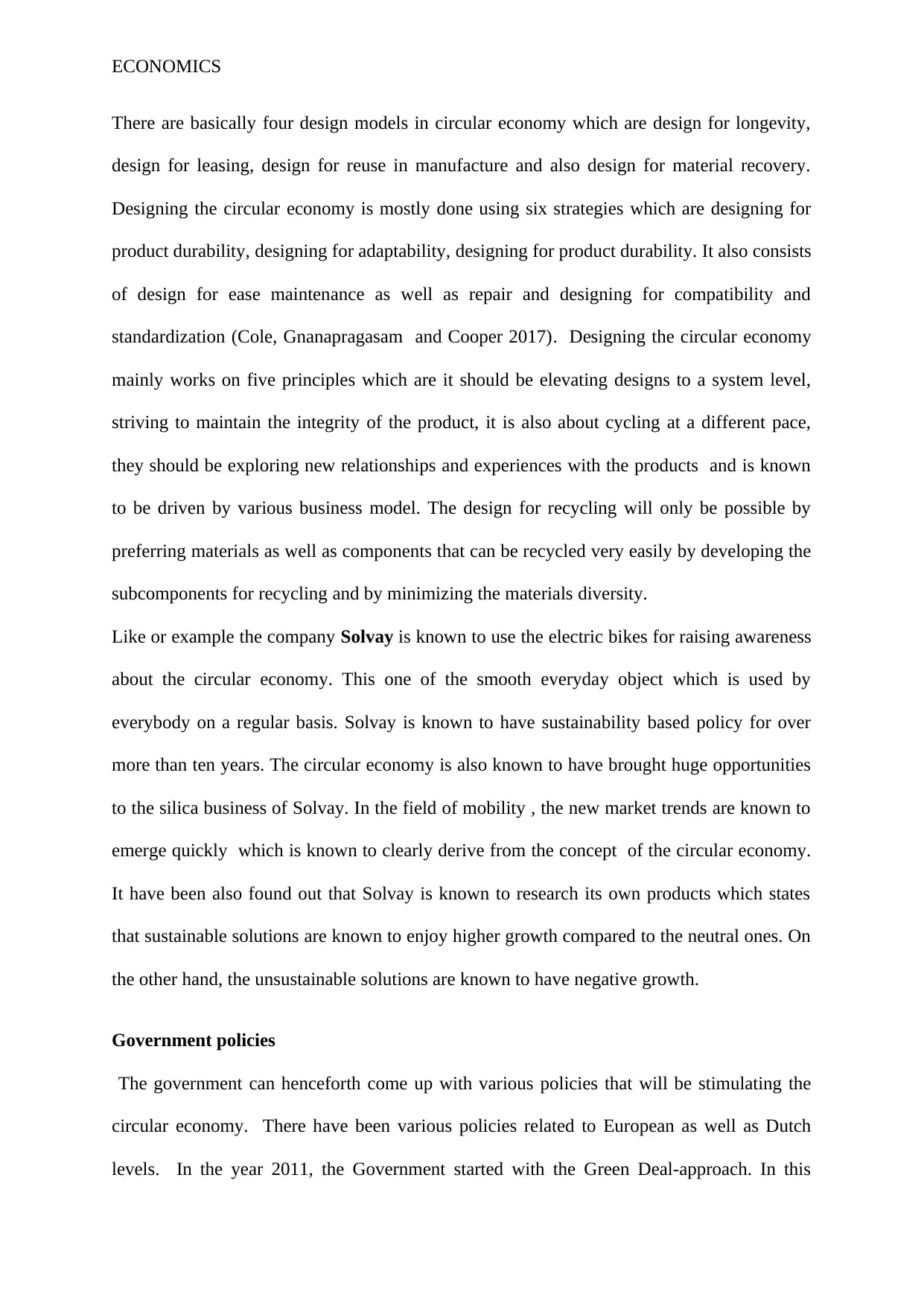
ECONOMICS
There are basically four design models in circular economy which are design for longevity,
design for leasing, design for reuse in manufacture and also design for material recovery.
Designing the circular economy is mostly done using six strategies which are designing for
product durability, designing for adaptability, designing for product durability. It also consists
of design for ease maintenance as well as repair and designing for compatibility and
standardization (Cole, Gnanapragasam and Cooper 2017). Designing the circular economy
mainly works on five principles which are it should be elevating designs to a system level,
striving to maintain the integrity of the product, it is also about cycling at a different pace,
they should be exploring new relationships and experiences with the products and is known
to be driven by various business model. The design for recycling will only be possible by
preferring materials as well as components that can be recycled very easily by developing the
subcomponents for recycling and by minimizing the materials diversity.
Like or example the company Solvay is known to use the electric bikes for raising awareness
about the circular economy. This one of the smooth everyday object which is used by
everybody on a regular basis. Solvay is known to have sustainability based policy for over
more than ten years. The circular economy is also known to have brought huge opportunities
to the silica business of Solvay. In the field of mobility , the new market trends are known to
emerge quickly which is known to clearly derive from the concept of the circular economy.
It have been also found out that Solvay is known to research its own products which states
that sustainable solutions are known to enjoy higher growth compared to the neutral ones. On
the other hand, the unsustainable solutions are known to have negative growth.
Government policies
The government can henceforth come up with various policies that will be stimulating the
circular economy. There have been various policies related to European as well as Dutch
levels. In the year 2011, the Government started with the Green Deal-approach. In this
There are basically four design models in circular economy which are design for longevity,
design for leasing, design for reuse in manufacture and also design for material recovery.
Designing the circular economy is mostly done using six strategies which are designing for
product durability, designing for adaptability, designing for product durability. It also consists
of design for ease maintenance as well as repair and designing for compatibility and
standardization (Cole, Gnanapragasam and Cooper 2017). Designing the circular economy
mainly works on five principles which are it should be elevating designs to a system level,
striving to maintain the integrity of the product, it is also about cycling at a different pace,
they should be exploring new relationships and experiences with the products and is known
to be driven by various business model. The design for recycling will only be possible by
preferring materials as well as components that can be recycled very easily by developing the
subcomponents for recycling and by minimizing the materials diversity.
Like or example the company Solvay is known to use the electric bikes for raising awareness
about the circular economy. This one of the smooth everyday object which is used by
everybody on a regular basis. Solvay is known to have sustainability based policy for over
more than ten years. The circular economy is also known to have brought huge opportunities
to the silica business of Solvay. In the field of mobility , the new market trends are known to
emerge quickly which is known to clearly derive from the concept of the circular economy.
It have been also found out that Solvay is known to research its own products which states
that sustainable solutions are known to enjoy higher growth compared to the neutral ones. On
the other hand, the unsustainable solutions are known to have negative growth.
Government policies
The government can henceforth come up with various policies that will be stimulating the
circular economy. There have been various policies related to European as well as Dutch
levels. In the year 2011, the Government started with the Green Deal-approach. In this

ECONOMICS
program the government wants to allow room for the innovative and sustainable initiatives
from the society. The programme helps in doing this by removing the laws and legislations
creating new markets and providing good information. The green deal is also aimed at the
minimal usage and recusing of resources and products in the design. The Green Deal aims to
support the transition to a circular and inclusive economy with reference to material flows in
the construction sector. There is also a presence of European deal where there are various
range of policies that takes place at the European level which is known to address part of the
transition to the circular economy (Cole, Gnanapragasam and Cooper 2017). The circular
economy package is known to include a communication strategy. The policies which are need
to be implemented and are necessary for attaining the circular economy are focussing on the
goals of sustainable development, tax reforms from labour to resources and also an
acceptable budget for the development aid.
For stimulating the circular innovations, the government can participate in the market. By
adapting its procurement policy the government can influence the market. When the
government will be acting as launching customer, the significant interactions between the
business and government will be achieved.
Conclusion
In order to conclude it can be stated that the attaining circular economy will be saving the
non renewable resources for the future generation. The circular economy is the industrial
system which regenerative by intentions and designs. It is known to replace with the end of
life concept with the restoration, shifting towards the usage of renewable energy, elimination
of the use of toxic materials. In this report the circular economy of the electric motorcycles
are being described. Most of the components of the electric scooters including the electrical
parts are mostly manufactured by the suppliers and then they are supplied to the factory. The
extraction and processing of raw materials for electric vehicles can lead to significant
program the government wants to allow room for the innovative and sustainable initiatives
from the society. The programme helps in doing this by removing the laws and legislations
creating new markets and providing good information. The green deal is also aimed at the
minimal usage and recusing of resources and products in the design. The Green Deal aims to
support the transition to a circular and inclusive economy with reference to material flows in
the construction sector. There is also a presence of European deal where there are various
range of policies that takes place at the European level which is known to address part of the
transition to the circular economy (Cole, Gnanapragasam and Cooper 2017). The circular
economy package is known to include a communication strategy. The policies which are need
to be implemented and are necessary for attaining the circular economy are focussing on the
goals of sustainable development, tax reforms from labour to resources and also an
acceptable budget for the development aid.
For stimulating the circular innovations, the government can participate in the market. By
adapting its procurement policy the government can influence the market. When the
government will be acting as launching customer, the significant interactions between the
business and government will be achieved.
Conclusion
In order to conclude it can be stated that the attaining circular economy will be saving the
non renewable resources for the future generation. The circular economy is the industrial
system which regenerative by intentions and designs. It is known to replace with the end of
life concept with the restoration, shifting towards the usage of renewable energy, elimination
of the use of toxic materials. In this report the circular economy of the electric motorcycles
are being described. Most of the components of the electric scooters including the electrical
parts are mostly manufactured by the suppliers and then they are supplied to the factory. The
extraction and processing of raw materials for electric vehicles can lead to significant
⊘ This is a preview!⊘
Do you want full access?
Subscribe today to unlock all pages.

Trusted by 1+ million students worldwide
1 out of 16
Related Documents
Your All-in-One AI-Powered Toolkit for Academic Success.
+13062052269
info@desklib.com
Available 24*7 on WhatsApp / Email
![[object Object]](/_next/static/media/star-bottom.7253800d.svg)
Unlock your academic potential
Copyright © 2020–2025 A2Z Services. All Rights Reserved. Developed and managed by ZUCOL.





